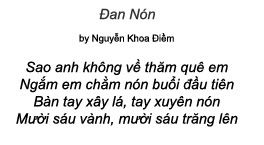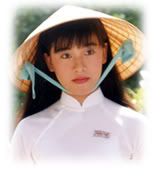 This essay is obviously not about the presidential primaries, domestic politics, the economy, the occupation of Iraq or foreign policy. The boomers among us will see some historical relevance. For some others it might bring back few special memories. This is a diary about a simple but elegant hat, a hat that some might consider to be symbolic of a poignant era in history, along with some additional words and photos of the flowing ao dai that is often worn together with the hat.
This essay is obviously not about the presidential primaries, domestic politics, the economy, the occupation of Iraq or foreign policy. The boomers among us will see some historical relevance. For some others it might bring back few special memories. This is a diary about a simple but elegant hat, a hat that some might consider to be symbolic of a poignant era in history, along with some additional words and photos of the flowing ao dai that is often worn together with the hat.
A change of pace here. Light reading and an attempt to provide a few eye-pleasing images and perhaps brighten your day a little bit.
The hats are traditionally known as a nón lá or a nón bài thơ. The former term refers to plain conical hat made with latania palm fronds, the latter refers to a conical hat with poetry and decoration placed between the two layers of leaves of the palm fronds. Bài thơ is the Viet word for poem.
The conical hat is a symbol of traditional Vietnamese life. It is practical and fashionable. It’s extremely durable, very light weight and provides protection from the tropical sun and from monsoon rains. It is worn throughout Viet Nam and also appears in rural areas of neighboring Laos and bordering areas of Cambodia. It is worn by farmers, fishermen, merchants, fashion models, students, adults, children, men, women, city-dwellers and country folk. It is seen in the fields, on the streets, in the market places and in traditional ceremonies.
 Vietnamese conical hats are made from the dried leaves of the latania, a palm with fan-shaped fronds, layered over 16 brims fashioned from small diameter, cylindrical-shaped strips of bamboo.
Vietnamese conical hats are made from the dried leaves of the latania, a palm with fan-shaped fronds, layered over 16 brims fashioned from small diameter, cylindrical-shaped strips of bamboo.
Conical hats are made throughout the country. Different regions have their own versions of the basic nón design. The area around Hue, in central Viet Nam, is quite well known for its poem hats, which are light in weight yet very sturdy, and are inlaid with poems and images of well known landmarks in the Hue area. These are among the most favorite souvenir purchases made by visitors to Hue.
 A view looking inside of the nón bài thơ (image left) shows a sampling of the inlay work. An image of the Thien Mu Pagoda (there are interesting photos of the actual pagoda at this link) can be seen in the lower left-center quadrant of the hat. Though it is difficult to see in the image, there is a poem inlaid in the lower right portion of the photo. The source of this photo is Google Images. One of the poems used is shown below along with an English translation.
A view looking inside of the nón bài thơ (image left) shows a sampling of the inlay work. An image of the Thien Mu Pagoda (there are interesting photos of the actual pagoda at this link) can be seen in the lower left-center quadrant of the hat. Though it is difficult to see in the image, there is a poem inlaid in the lower right portion of the photo. The source of this photo is Google Images. One of the poems used is shown below along with an English translation.
The Vietnamese version of the poem below was provided by my niece. The translation to English is my own.



 Making nón bài thơ has been a traditional craft for many generations in the Hue area. In the Phu Cam neighborhood, on the southern outskirts of Hue, many local residents engage in this craft. A large selection of conical hats for sale can be found a the main market-place along the Perfume River near the Citadel in Hue.
Making nón bài thơ has been a traditional craft for many generations in the Hue area. In the Phu Cam neighborhood, on the southern outskirts of Hue, many local residents engage in this craft. A large selection of conical hats for sale can be found a the main market-place along the Perfume River near the Citadel in Hue.
Nón bài thơ worn with the traditional áo dài (the pronunciation sounds like “ow yai” in the South and transitions to “ow zai” in the North) brings an aura of charm and grace to those women who wear it. Hue school girls wearing white ao dai and non bai tho have become an endless source of inspiration for poets and writers.
The colors of an ao dai are an indication of the age and the status of the wearer. Schoolgirls usually wear white symbolizing purity. As they grow a bit more mature they begin wearing pastel shades. Married women wear patterns and darker colors.
In his 1982 novel Saigon, Anthony Grey described the Ao Dai as “demure and provocative…women seem not to walk, but to float gently beneath the tamarinds on the evening breezes.” It is often said that the ao dai covers everything but hides nothing.
Every ao dai is custom made, accounting for the fit that creates such a flattering look. Stores specialize in their production and a team of cutters, sewers and fitters ensure that the final product will highlight the figure of the wearer. Thuy, a fitter in Ho Chi Minh City, says, “To create the perfect fit, customers take their undergarments and shoes with them for the fittings.” The pants should reach the soles of the feet and flow along the floor.
Source – Things Asian
The photo in the blockquote above, on the right side, is from a collection by Tanya Truong. Her slide show with larger images may be seen here. Very nice!
More ao dai images can be viewed here including one of George W. Bush at the APEC Summit in Hanoi in 2006. I’m sure there are many other people you’d rather see in an ao dai, and there are a few others – much more pleasing to the senses, on the other end of the link.

